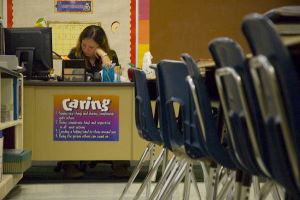[ad_1]
The sounds ringing through school hallways from day to day don’t always dissipate with the tide of students after the closing bell. New research indicates that many teachers are left with those sounds ringing in their ears long after they’ve wiped the board clean and retired for the night.
While it may seem surprising, teachers do have a particularly high level of exposure to loud sounds, mainly those that come from working with children. Imagine the headaches you get from dealing with your own children. Now think about how the noise level would compare if, instead of just the few kids of your own, you had a revolving group of 25 crowding in one room of your house. All. Day. Long.

rate of hearing loss than the national average?
Teachers report having to repeat themselves,
misunderstanding speech and feeling stressed
more than the typical American.
According to a September report from EPIC Hearing Healthcare, 15 percent of teachers report a diagnosed hearing loss, compared to 12 percent of workers nationwide. That might not seem like a huge difference, but EPIC also found teachers between the ages of 18 and 44 reported a significantly higher rate of diagnosed hearing problems (26 percent) than the national average (17 percent). That 9 percent difference, EPIC says, is evidence that the work environment is a major contributing factor to teachers’ hearing problems.
Founded in 1997, California-based EPIC is the largest provider of hearing benefits in the nation, having molded its Hearing Service Plans the way traditional supplemental dental and vision benefits are designed. EPIC’s teacher survey revealed an oft-overlooked problem in our nation’s schools. While we concentrate all of our worry on our children’s hearing loss, we’ve forgotten completely about the teachers.
EPIC’s survey found that only 19 percent of teachers were offered hearing insurance through their employers, although 60 percent were concerned about developing hearing loss. Furthermore, the survey found that 27 percent of surveyed teachers suspected they had a hearing loss and yet had not sought treatment for a variety of reasons. Of the teachers with suspected but untreated hearing loss, more than half admitted to asking people to frequently repeat themselves, one-third frequently misunderstood what was said and one-fourth reported feeling stressed or tired from the strain of listening or talking for an extended period of time.
Perhaps even more concerning is why these teachers have not visited a hearing health practitioner to have their hearing assessed. More than half of teachers surveyed said they would be concerned if their employer suspected them of having hearing loss. Another factor could be the cost. Since only 19 percent of teachers were offered hearing insurance, the cost of hearing aids or check-ups might not be covered under their umbrella health insurance plan.
These findings reinforce those of a 2007 study done by the National Center for Biotechnology Information in the Department of Health and Human Services. The vast majority of teachers surveyed reported excessive noise in their classrooms (93.5 percent) and “auditory symptoms” (65 percent). A survey of classrooms found that noise levels exceeding the generally considered safe level of 85 decibels were common across all levels of education.
Access to hearing health insurance
Hearing insurance is not a benefit that is always covered under an overall health plan and there aren’t as many choices for supplemental hearing insurance as there are for dental or vision. According to the American Speech-Language-Hearing Association, 20 states mandate insurance coverage for hearing health, but 17 of those states only mandate coverage for children.
Three states require insurance companies to cover hearing aids for all individuals regardless of age. Arkansas state law calls for hearing aid coverage of at least $1,400 per ear every three years. New Hampshire law requires coverage of at least $1,500 per ear every five years. Rhode Island requires only $700 per ear every three years.
With 30 million people over the age of 12 living with hearing loss, and only 16 percent of adults aged 20-69 who could benefit from hearing aids actually using them, there is a lot of potential growth in the hearing insurance market.
“We’re finding increasing interest from retired teachers associations in hearing insurance, especially as they are better educated on their members’ higher risk, both from age and their profession,” Ernest Stobel, president of E.J.S. Insurance Services, Inc., an insurance brokerage firm, told EPIC. “Because of this, we’re positioning hearing insurance as an equal player with dental and vision as important voluntary benefits to promote overall wellness.”
[ad_2]
Source link

